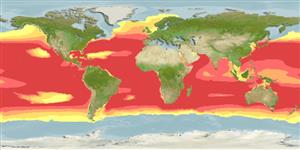Common names from other countries
Environment: milieu / climate zone / depth range / distribution range
Ecologia
marinhas batipelágico; oceanódromo (Ref. 51243); intervalo de profundidade 0 - 1050 m (Ref. 44036). Deep-water
Eastern Atlantic: Morocco to Namibia (gap over region of cyclonic gyre 4°-6°S). Western Atlantic: USA to Subtropical Convergence, [but absent over minimum region off Brazil according to Ref. 4479] and lower abundance in Sargasso Sea. Also in the southern Indian Ocean, North and South Pacific (absent in equatorial waters). South China Sea (Ref.74511).
Length at first maturity / Tamanho / Peso / Idade
Maturity: Lm ?, range 5 - ? cm
Max length : 6.0 cm SL macho/indeterminado; (Ref. 4479)
Espinhos dorsais (total) : 0; Raios dorsais moles (total) : 13 - 15; Espinhos anais: 0; Raios anais moles: 21 - 25; Vértebras: 38 - 40. Branchiostegal rays: 8-9 (Ref. 31442). Anal organs 14-15; males with single supracaudal gland filling about 1/2 the supracaudal space, females with 3 coalesced infracaudal gland patches, sometimes separate (Ref. 39633).
Oceanic, found below 1,000 m during the day and from the surface to 200 m at night (Ref. 4479). Neustonic to mesopelagic (Ref. 58302). Oviparous, with planktonic eggs and larvae (Ref. 31442). Lipid content is 3.3 % in fresh body weight and wax ester is 10 % in total lipids (Ref. 9197). Reach sexual maturity at 4,6 cm (Ref. 47377).
Hulley, P.A., 1990. Myctophidae. p. 398-467. In J.C. Quero, J.C. Hureau, C. Karrer, A. Post and L. Saldanha (eds.) Check-list of the fishes of the eastern tropical Atlantic (CLOFETA). JNICT, Lisbon; SEI; Paris; and UNESCO, Paris. Vol. 1. (Ref. 4479)
Categoria na Lista Vermelha da IUCN (Ref. 130435)
CITES (Ref. 128078)
Not Evaluated
Ameaça para o homem
Harmless
Utilização humana
Ferramentas
Relatórios especiais
Descarregue XML
Fontes da internet
Estimates based on models
Preferred temperature (Ref.
115969): 8.6 - 20.6, mean 13.7 (based on 1088 cells).
Phylogenetic diversity index (Ref.
82804): PD
50 = 0.5020 [Uniqueness, from 0.5 = low to 2.0 = high].
Bayesian length-weight: a=0.00692 (0.00297 - 0.01609), b=3.13 (2.93 - 3.33), in cm Total Length, based on LWR estimates for this (Sub)family-body shape (Ref.
93245).
Nível Trófico (Ref.
69278): 3.2 ±0.31 se; based on food items.
Resiliência (Ref.
120179): Elevada, tempo mínimo de duplicação da população menor que 15 meses (Preliminary K or Fecundity.).
Fishing Vulnerability (Ref.
59153): Low vulnerability (10 of 100).
